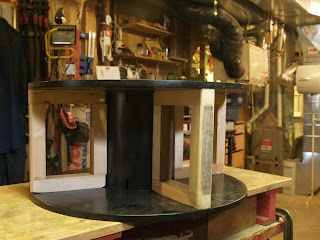Recently KREG Tools sent a post with a plan. We have had a wash tub sitting around in the yard for a couple of years. A contractor had used it to mix mortar for a small job and then left it when he packed up. The KREG plan was designed to make that old tub useful. My wife plans to fill ours with salad greens.
Friday, April 30, 2021
Go Anywhere Garden
Tuesday, April 27, 2021
Making A Box Or Two
I don't really have any projects ahead of me so I think I will make some boxes. You can always use another box. To begin I made some lumber. In my lumber rack are many 18 - 30 inch long bits of left over wood. Much of it is rough, reclaimed from skids or construction lumber. I decided to make some 3/8 and some 1/2 slabs ahead of need. The joiner and the planner have to be rolled into the centre of the shop and they are both noisy. I wanted to get the unpleasant part of the work out of the way first.
Tuesday, April 20, 2021
Small Projects and Lessons Learned
Tuesday, April 13, 2021
Book Up Date - It Is Finished
The last few photographs of the process show the cloth covering being glued to the boards. Just like all workshop projects, you can never have too many clamps. I stretched white cloth around the edges of the boards and clamped it 'til dry.
Monday, April 5, 2021
Book Repair
I have always loved books and reading, maybe more than wood working. In the early 1980's I took a multi-week community college course to learn book binding and restoration. Book binding requires few special tools but endless patience. Over the last forty years I have bound a few books, I use the tricks and skills to make my own watercolour sketch books and I have repaired (saved) a few books. I am not a trained conservator and I don't do leather binding.
This last week we have enjoyed some good spring weather and so we've been outside and my time in the workshop has been spent on maintenance sorts of things which are not very interesting, not even to me.
Mainly my energy has been focused on restoring and re-binding my late Mother-in-Law's old, old cook book. The cook book has many loose pages and the cover is falling right off. Clearly it was a well loved and heavily used cook book. I'm told it is the German equivalent of our "Joy of Cooking", a go to book for home cooks.
When dealing with book repairs there are a few special tools:
Transparent Mend Tissue, a type of tape, that isn't plastic and doesn't yellow.
Linen binding tape - used to attached the cover boards to the body of the book.
sharp scissors, tweezers, very sharp knife, bone folder, straight edge, rubber cement, paste, spray bottle of water, magnifying glass. dental pick and cutting mat.
The first thing I did was go through every attached page and tape any tears in the pages. The linen tape is 1/2 inch by 12 feet. To repair all the tears I used 15 feet of tape. There were many torn pages.
All the pages are here, it is just a case of smoothing them out, repairing or trimming the frayed edges and carefully gluing the pages in where they belong. A full restoration would cut the signatures free and re-sew them while putting the loose pages back. I have found that sewing signatures requires more practice to do it well than I have acquired.
Really crumpled papers unfold better when slightly dampened, other wise the paper can be too brittle. I have only five pages left to re-attach, that is about an hour of fussy work, for me. A skilled experienced book binder would be quicker. So today I will finish putting the pages back into the book and tomorrow begin the work on the outside. (the covers etc.)
Happy Spring time everyone.
cheers, ianw


























